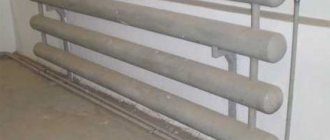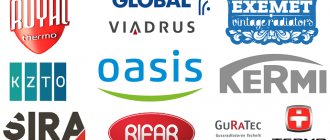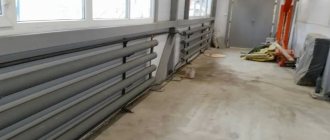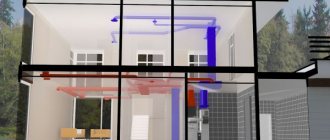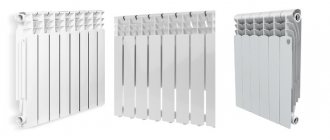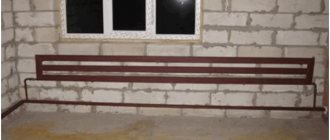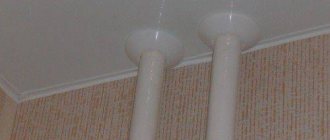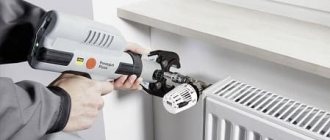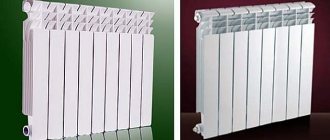Heating registers made of steel pipes are a common type of heating devices. They are a welded or prefabricated structure made of pipes arranged horizontally. They are connected by jumpers to allow the passage of the coolant.
The number of radiators used is very large, but the registers have not lost their relevance until this time. These devices are made using different materials, and each of them has its own disadvantages and advantages.
Kinds
A heating register made from pipes can be made of the following metals:
- aluminum;
- cast iron;
- steel.
Aluminum heating registers are most popular mainly due to their low weight, good thermal output, excellent resistance to corrosion processes, long service life and the absence of joints and welds.
Aluminum pipes are made by monolithic casting. Used in residential and administrative premises. The main disadvantage of these devices is their considerable cost.
Heating registers made of cast iron are easy to install, since they have a flanged monolithic connection. At the time of installation, a second flange is attached to the heating pipeline by welding. Then using bolts they make a strong connection.
Heating registers made of steel pipes are installed into the heating system by welding. Well-carried out welding work guarantees long service life of the entire heating system.
The following types of registers can be distinguished:
- stationary;
- mobile.
Stationary registers involve heating the coolant using heating boilers. Mobile devices use an electric tubular electric heater, which operates from a 220 V power supply. These registers are used in working construction houses and areas where finishing work is carried out.
Here are some advantages of installing registers in a radiator heating system:
- Long service life: steel pipes do not require repair for at least 25 years.
- High degree of reliability and safety. The main condition for such reliability is strong welding of the seams.
- An open-type heating system can be installed in large rooms. The low resistance to coolant circulation makes it possible to use large-diameter pipes for the register.
Nowadays, heating registers are not installed in premises as often, since modern devices appearing on the heating equipment market, which represent an alternative.
The disadvantages of registers include the following points:
- They are not attractive. The registers are located along the wall throughout the room; it is a thick steel pipe.
- The small area of contact with the air in the room leads to a reduced rate of heat output, zero use of convection.
- A considerable price for supplying the heating system with registers and the complexity of installation. Registers made of large-diameter steel pipes cost a lot on the building materials market, and during installation work it is necessary to use welding.
Self-installation
Split bolt mounting
Two installation methods:
- removable bolt connection,
- non-detachable welding connection.
The choice should be based on the weight and size of the device, and also take into account the characteristics of the heating system. You can take the rules for installing heating radiators as a basis; there is no fundamental difference.
Slope indicator - it is important to take into account, when connecting to a gravity system, the slope along the flow of the coolant. In systems where pumping equipment is not used and where the driving force is the difference in its partial pressure there are no such problems
In systems where pumping equipment is not used and where the driving force is the difference in its partial pressure, there are no such problems.
Installation rules:
- The recommended distance, in accordance with the technological process, from the wall and windows is at least 20 cm.
- Detachable installation requires the use of only paranitic pads or flax used in plumbing work,
- All steel heating registers must be painted to avoid rusting.
- It is better not to carry out installation during the heating season.
A comparative analysis of the calculated and actual power of the register can be carried out at the end of the test launch of the system, and if necessary, design changes can be made.
Advantages and disadvantages
Heating registers made of smooth pipes have many advantages:
- For large premises they are one of the best options for heating devices. Due to their considerable length, they provide uniform heating and create comfortable conditions. The heating is not local, but extensive.
- The hydraulic resistance is very low compared to cast iron or steel radiators. This allows you to significantly reduce pressure losses in the system, and, accordingly, the costs of pumping coolant. This same feature makes it possible to use an open heating system with natural circulation for large rooms.
- Straight sections of large diameter pipes are less susceptible to silting and overgrowing, unlike radiators of complex shapes. Therefore, heating registers practically do not need to be flushed.
- A simple design can be made with your own hands from available materials with significant savings.
- The service life is quite long, at least 25 years. The degree of reliability depends mainly on the quality of the welds.
- The smooth surface makes cleaning easy. This feature allows registers to be used in rooms with increased sanitary standards.
- Convenient for drying towels, linen and clothes.
The disadvantages of registers made of smooth pipes include:
- Small heating surface per unit length, which forces the use of large-sized devices;
- High metal consumption;
- Large diameters force the use of a large volume of coolant, which makes the system very inertial and difficult to regulate;
- The unattractive appearance of budget models and the huge price of non-standard design configurations.
Application
For the most part, registers are used in various industries. Serious dimensions and noticeable coolant consumption - all this is suitable for heating workshops, warehouses and other premises with a large area.
Heating registers provide optimal efficiency when used in industrial buildings. Conventional radiators are inferior to such heating devices, since they have better heat transfer and hydraulics. At the same time, the cost of their production is relatively low and they are cheap to operate, which makes it possible to organize heating systems that are economically beneficial.
Registers of this type are recommended to be installed in premises that are subject to strict sanitary safety standards, for example, these include kindergartens. Such devices are easy to maintain clean, as they can be cleaned from various types of contaminants without significant effort.
At the same time, heating registers cannot be considered economical. This is due to the consumption of significant volumes of coolant to maintain their functionality, which forces them to waste a lot of energy.
Application based on steel pipes is possible in heating systems characterized as single-pipe or two-pipe, regardless of the type of coolant circulation: forced or gravity.
Materials for production
Most often, heating registers are made of smooth steel pipes in accordance with GOST 3262-75 or GOST 10704-91. The use of electric welded pipes is preferable due to their ability to withstand higher pressures. However, in practice, water and gas pipes are also quite common, and they are operated no less successfully. Such heating devices can easily withstand all kinds of mechanical damage and loads, as well as work with any coolant.
There are also stainless steel models. They are installed in rooms with increased requirements for aesthetics and durability. Due to the increased cost, the use of stainless steel registers is most justified in bathrooms. The high corrosion resistance and variety of configurations of stainless steel heated towel rails allow them to be used even in the most modern bathroom interiors.
Aluminum and bimetallic registers are more efficient in terms of heat transfer. They are lightweight and aesthetically pleasing, and work perfectly in individual heating systems with well-organized water treatment. In other cases, low quality coolant leads to rapid failure of devices.
Sometimes you can find registers made of copper. They are usually used in systems where the main wiring is copper. They are easy to work with, very attractive and durable. In addition, the thermal conductivity of copper is approximately 8 times higher than steel, which makes it possible to significantly reduce the size of the heating surface. A common disadvantage of all devices made of non-ferrous metals - sensitivity to operating conditions - limits the scope of application of copper registers.
What are there
Heating registers are made of different materials and have different shapes. Each has pros and cons.
What are they made from?
If we talk about materials, the most common is steel, or rather electric-welded steel pipes. Steel does not have the best heat transfer, but this is compensated by its low price, ease of processing, availability and a large selection of standard sizes.
It is very rare to find pipes made of stainless steel - for decent power a large number of pipes are required, and you have an idea how much stainless steel products cost. If they did, it was probably a long time ago. They also use galvanized steel, but it is more difficult to work with - you won’t be able to cook it.
Registers made of copper pipes have high heat transfer and an equally high price
Sometimes they make copper registers - they are used in those networks where the wiring is made with copper pipes. Copper has high heat transfer (four times more than steel) and therefore their sizes are much more modest (both in length and in diameter of the pipes used). In addition, the distribution pipes themselves (if they are not hidden in the wall or floor) give off a sufficient amount of heat. At the same time, the plasticity of this metal allows pipes to be bent without any special tricks or effort, and welding can be used only at the junction of different pieces. But all these advantages are offset by two big disadvantages: the first is the high price, the second is the capriciousness of copper to operating conditions. Everything is clear about the price, but there are a few explanations about the operation:
- Requires neutral and clean coolant, free of solid particles
- the presence of other metals and alloys in the system is undesirable, except for compatible ones - bronze, brass, nickel, chromium, therefore all fittings and fittings will need to be made from these materials;
- Careful grounding is mandatory - without it, in the presence of water, electrochemical corrosion processes begin;
- the softness of the material requires protection - we need screens, covers, etc.
There are registers made of cast iron. But they are too bulky. In addition, they have a very large mass; no less massive racks need to be made for them. Plus, cast iron is fragile - one blow and it can crack. It turns out that this type of registers also needs protective covers, and they reduce heat transfer and increase cost. Moreover, installing them is complex and hard work. The advantages include high reliability and chemical neutrality: this alloy does not care what coolant it works with.
Cast iron finned tube registers
In general, copper and cast iron are not easy. So it turns out that the optimal choice is steel registers.
Specifications
Technical requirements for heating devices, including tubular radiators, are standardized by GOST 31311-2005. According to this standard, pipes in accordance with GOST 3262, GOST 8734, GOST 10705, GOST 10706 with a wall thickness of at least 1.25 mm must be used for their manufacture. At the same time, heated towel rails are allowed to be made from carbon steel with a wall of at least 3 mm, stainless steel, as well as brass (copper-zinc alloys) in accordance with GOST 15527.
It is also possible to use other materials if the heating devices comply with all provisions of the standard and have the necessary strength characteristics. The design of devices is not standardized and remains at the discretion of the manufacturer, subject to compliance with basic requirements. This gives complete freedom for creativity and allows you to create unique design configurations of tubular radiators, which significantly expands the scope of their application.
The characteristics of heating registers made of smooth pipes depend on the selected material, size and configuration. They are determined using special formulas, tables or manufacturer’s materials.
Let's consider the main parameters of conventional steel registers. They are characterized by the use of large diameter pipes, mainly in the range of 32 – 219 mm. They can withstand operating pressure up to 100 Pa (10 kgf/m²). The coolant can be a variety of liquids - water, antifreeze, oil - or high-temperature steam.
Having a detailed drawing, a register from smooth steel pipes can be made by any craftsman with welding skills. To do this, just find the source material, a welding machine and an angle grinder. You can also order the register at the factory according to individual drawings.
Important! It is necessary to maintain not only the length, diameter and number of pipes, but also the distance between them. Too close a location significantly reduces the heat transfer of the device due to the mutual influence of the elements. If the distance is made too large, then the height of the device can be enormous and not convenient to install and use. The optimal spacing of the rows of the heating register is considered to be 1.5 radii, but not less than 50 mm.
To obtain the best results, all parameters must be determined on the basis of thermal calculations, based on the required heat transfer and the characteristics of the room. Without proper calculation, even a well-made register may not be able to cope with heating the available area.
Main classification
The registers offered by the market can be divided into two types:
- Coil (S-shaped)
- Sectional
Coil (S-shaped)
Coil registers consisting of several sections have become widespread. The latter are connected to each other by arcs whose diameter is comparable to the sectional one. The result is a pipe of a continuous configuration, for which the entire surface is working. The efficiency of the installations is very high.
For the manufacture of coil registers, a smooth-walled steel pipe with a high carbon content is used. The areas where narrowing occurs are eliminated, due to which the hydraulic resistance inside is significantly reduced. There are also models on the market made of low-alloy or stainless steel and cast iron.
Sectional
The most popular among private owners are sectional heating registers, consisting of pipes closed with plugs and connected to each other. The coolant is passed through the upper pipe, at the end of which it flows into the next one - and so on until the exit.
To increase the heat transfer coefficient, the transition for the coolant between the pipes is made as close to the edge as possible. Plugs between pipes come in one of two types: elliptical or flat. The inlet pipe is made to be flanged, threaded or welded.
Sectional heating registers are equipped with a threaded fitting, through which a diverter for accumulated air masses is mounted. The diameter of the main horizontal pipes varies and varies from 25 mm to 40 cm (in household appliances - up to 16 cm). The transition is carried out using pipes of a smaller cross-section. Another feature of the installations is that the maximum pressure inside should not exceed 1 MPa.
Subtypes of heating registers
In addition to their own configuration, heating registers can be divided into subtypes according to the following criteria:
- Location options
- Material of manufacture
Calculation of heating registers made of smooth pipes
Calculation of heating registers is carried out to determine the amount of heat supplied from the existing register, as well as to determine the required dimensions of the device to provide the required heating power.
Advice: before you start calculating the register parameters, you should clearly determine the temperature regime and heat loss of the room. The method for calculating them is a separate topic, but if you need high-quality heating, then it’s worth understanding this issue so as not to redo it later.
The amount of heat (W) coming from the pipe is determined by the formula:
Q=K ·F · ∆t,
Where:
K – heat transfer coefficient, W/(m2 0С), taken depending on the pipe material and coolant parameters;
F – pipe surface area, m2, calculated as the product of π d l,
where π = 3.14, and d and l are the diameter and length of the pipe, respectively, m;
∆t – temperature difference, 0С, determined in turn by the formula:.
∆t= 0.5·(t1 + t2) – tк,
where: t1 and t2 are the temperatures at the inlet and outlet of the boiler, respectively;
tk – temperature in the heated room.
Note: For a single steel pipe filled with water, the heat transfer coefficient to air is generally 11.3 W/(m2 0C). For a register with several rows, a reduction factor of 0.9 for each thread is approximately accepted.
The values of heat transfer coefficients for steel smooth-tube registers are given in the table.
To determine the size of the register, the required thermal power is divided by the heat transfer per linear meter of pipe. This will give the approximate total length of the threads. Next, taking into account the dimensions of the room, the width of the device is taken and the number of rows is calculated.
Advice: since increasing the diameters of the threads and their number reduces the efficiency of the device, the heat transfer of the register should be increased primarily by increasing its length.
For faster calculations, you can use an online calculator, but there is a high risk of getting an erroneous result. Therefore, before using automatic calculations, you should perform at least one manually and compare the results.
Non-freezing liquids have a lower heat capacity and give off less heat than water. Thus, registers with antifreeze must have an increased surface area compared to those operating with water. To calculate them, it is necessary to take into account the properties of the liquid itself.
How to calculate heat transfer?
The required amount of material can be calculated based on the temperature parameters that need to be obtained in the room. At the household level, this step is usually skipped - they make heating registers with their own hands “by eye” according to the principle “the more, the better.”
But it is better to make simple calculations of heat transfer, for which you do not need to be a mathematician.
All you need is:
- Calculate the area of the room.
- Learn about the heat transfer properties of steel.
- Select the optimal pipe diameter.
The area of a room is calculated by multiplying its length by its width (S = L*W). However, for more accurate calculations, it is recommended to calculate the volumetric parameter by adding the height (H) value to the calculations.
So, the final calculation formula takes the form:
V = L*W*H
For example, you need to calculate V of a room where the length is 5 m, width is 3 m, height is 2.15 m. The volume of the room is obtained: V = 5*3*2.15 = 30.25 m3. Based on this basic value, further calculations should be made to determine the amount of heat, the size and number of heating registers to make with your own hands.
Self-welded heating registers are blocks consisting of six steel pipes with a diameter of over 100 mm. Such batteries, made without proper calculations, can overheat the room being served.
First of all, the required amount of heat per calculated volume of the room is calculated to achieve the required internal temperature (W):
Qп.т = V * k (Tin – Tout),
where V is the volume of the room; k – heat transfer coefficient of the building walls; Tin – temperature inside; Tout – outside temperature.
The amount of heat generated by one register can be calculated using the formula:
Qр = q * L * (1-n),
where: q – heat flow from each horizontal and vertical pipe of the register (approximately 20-30 W/m); L – length of vertical and horizontal pipes of the register (m); n – coefficient of unaccounted heat flows (for metal pipes – 0.1).
The category of unaccounted heat loss also includes the hood in the garage. If the mechanical type is installed, the coefficient n must be increased to at least 0.2.
The number of registers, accordingly, is determined by the formula:
Nр = Qп.т. / Qр
Such a calculation method will most likely be assessed by design specialists as a simplified and crude form. However, this approach still seems to be a more rational action than calculating and making registers with your own hands by eye, without any calculations.
Selecting a heating device configuration
Homemade radiator designs are mainly made on the basis of metal pipes with a diameter of 80 - 150 mm.
Design features are limited to two versions:
- Lattice.
- Snake.
The lattice design of the heating battery differs from the “snake” in a slightly different circuit design, and, depending on the variations in such batteries, the distribution of the coolant may be different.
Options for circuit design of heating registers for their own production: 1 – one jumper and one-sided power supply; 2 – two jumpers and one-sided power supply; 3 – two-way power supply and 2 jumpers; 4 – two-way power supply and 4 jumpers; 5, 6 - multi-pipe
Coil structures actually have a monotonous design, implying strictly sequential movement of the coolant.
Lattice registers are constructed according to different schematics:
- with one or two jumpers and one-way power supply;
- with one or two jumpers and versatile power supply;
- parallel connection of pipes;
- sequential connection of pipes.
The number of pipes in one assembly can range from two to four or more. Rarely, there is also the practice of making single-pipe registers.
A coil assembly usually contains at least two pipes connected on one side by a blind jumper and on the other by a through jumper, which are made from two pipe bends (2x45º). It should be noted that the design of heating registers in the form of a coil is used much less frequently than “grid” designs.
Options for the possible manufacture of “snake” type registers. For coil-type register battery designs, the choice of manufacturing options is limited compared to lattice-type designs.
Both manufacturing options - lattice and coil - can be made not only on the basis of classic round pipes, but also on the basis of profile pipes.
Profile pipes seem to be a somewhat specific material, since they require a slightly different approach when assembling heating radiators. However, registers made from a profile pipe are more compact and take up less usable space, and this factor is also important.
Welding technology
Purely technologically, the connection of steel elements is made either by electric or gas welding, where the technology is almost the same
When welding registers, please note that in coil structures the joints are vertical seams, and in sectional ones they are both vertical and horizontal. It is easier to cook the latter because they are located in the plane of the table
The following requirements apply to the technology of welding horizontal seams (section + jumper):
- Tack can be carried out at one or two points, aligning the jumper vertically. Two points are located symmetrically relative to the axis of installation of the jumper.
- A joint connected by one tack point is cooked immediately, but the process must begin on the opposite side of the tack.
- A joint connected by two tack points is welded from the first point.
- Vertical joints in registers - connection of main pipes with plugs and 90° bends. The following requirements apply to seams of this type:
- If the pipe thickness is up to 3 mm, then the joint is scalded in one pass with a 2.5 mm electrode.
- If the thickness exceeds 4 mm, then welding is carried out in two passes: with a root seam, and on top with a facing roller.
- When connecting pipes with a diameter of more than 60 mm, welding is carried out in sections along the entire perimeter of the joint.
There are general rules of welding, which indicate purely technological techniques. For example, the end of a seam must be welded to the beginning, forming a “lock”. If welding is performed in two seams, then the second is carried out in the opposite direction of the first.
There are several welding parameters that you need to pay attention to when carrying out welding work. This is the diameter of the electrode, which is selected depending on the thickness of the steel workpieces being welded, this is the current strength supplied to the electrode from the welding machine, the polarity and voltage of the welding arc
Ratio of metal thickness to electrode diameter
| Metal thickness, mm | 1—2 | 3—5 | 4—10 | 12—24 | 30—60 |
| Electrode diameter, mm | 2—3 | 3—4 | 4—5 | 5—6 | 6 or more |
The current strength is selected depending on the diameter of the selected electrode. The dependence is as follows: I=Kd, where K is the coefficient of correlation with the diameter of the electrode.
| Electrode diameter, mm | >2 | 3 | 4 | 5 | 6 |
| Coefficient - "K" | 25—30 | 30—35 | 35—40 | 40—45 | 50—60 |
The algorithm used to create
- First, pipes of the required volume are prepared and cut into pieces of the required length.
- Afterwards, the internal cleaning of the pipe products is carried out. This allows you to reduce the resistance to movement of the coolant.
- Plugs are welded on the end parts. Some of them are equipped with holes.
- After this, the pipes, which will be located horizontally, are fastened with vertical pipes, which have a smaller diameter.
- Now it's time to install the cranes. They will be needed to release air accumulated in the pipeline.
- At the final stage, all seams are cleaned and the surfaces are painted.
Adviсe
Before you start making registers, you should take care of purchasing the appropriate materials. You will need pipes of one diameter or another and some length. Exact numbers are not given here, since the device of the type in question can be assembled from any pipes without focusing on their diameter and thickness. More important is to ensure optimal heat transfer, which involves carrying out calculations regarding the required surface area of the register.
To do this, you will need to determine the outer area of the entire system. The resulting value is then multiplied by 330 W. The use of this method is based on the statement that 1 m2 gives off 330 W of heat if the temperature of the medium is 60 °C and the air inside the heated room is 18 °C.
Advice! You don’t have to do manual calculations, but use a simple program in EXCEL and then correctly weld the register according to the exact parameters.
For people skilled in welding, assembling the structure will not be difficult. It will be necessary to prepare pipes and cut them into sections, and also take care of the plugs, for the manufacture of which a steel sheet will be required. Register assembly does not imply the presence of a strictly defined order of actions. Upon completion of welding work, it is necessary to ensure the tightness of the created structure.
Otherwise, the following advice can be given:
- you should select pipes with an optimal wall thickness, since too thin ones cool quickly enough, and thick ones take a long time to warm up;
- the upper section must be supplemented with a Mayevsky valve, with the help of which air is released;
- assembly of the register in the form of a coil involves the use of a pipe bender; if this is not possible, the rotary sections can be assembled from ready-made elbows;
- the coolant inlet must be equipped with a tap, and the outlet with a valve;
- The installation of the register should be carried out with a slight slope in the direction where the supply pipe is located, which ensures that the Mayevsky crane occupies the highest position.
Design features
Essentially, a register is one or more pipes connected to each other in parallel
Here it is important to create conditions so that the coolant flows sequentially from one pipe to another, releasing heat into the room. Therefore, two types of registers are made
Sectional
Several parallel pipes, the ends of which are closed with plugs. Jumpers are installed between them, through which the coolant flows from one section to another. It moves from top to bottom, that is, it enters the upper pipe and comes out of the lower one.
Important! The jumpers are installed in a checkerboard pattern. If between the first and second sections the jumper is installed on the left, then between the second and third - on the right
The diameter of the jumpers is much smaller than the diameter of the sections. For example, if the diameter of the main register element is 80 mm, then the jumpers are 32-40 mm.
Serpentine, their drawing
This is the same design, only the sections are connected to each other by double 90° bends of the same diameter as the main pipes, and a continuous pipe structure of one large diameter along the entire length is obtained. The heat transfer of this type of register is much higher than that of the previous version.
Photo 1. Drawing of a coil-type register, which is a continuous pipe structure of the same diameter along the entire length.
The advantages of the design include the low hydraulic pressure of the coolant inside the device, which allows a sufficiently large volume of hot water to pass through it.
Reference! The coil can be installed either horizontally or vertically.
How to install
There are two installation options: hang it on the wall or put it on a stand. The choice depends on the dimensions and weight of the resulting structure, as well as on the type of walls.
Quite often they do a combined installation: they weld racks, which are then attached to the wall. Even very massive registers can be installed in this way. This installation option also provides a high level of security.
Each such heating device must have an air vent at the top point. It is needed to bleed air from the system.
Types of equipment
Based on the material of manufacture, heating devices can be of 3 types:
- aluminum;
- steel;
- cast iron
Aluminum
Aluminum heating registers are lightweight, have high heat transfer and are resistant to corrosion. They are manufactured using monolithic casting technology without welds and have a long service life. However, the price of such products is quite high.
Steel
The most common type of equipment. Manufactured from smooth high carbon steel pipes
They are mounted by welding, so special attention should be paid to the quality of the connecting seams
Cast iron
They have a large number of ribs. Their walls are very thick, which is why it takes a lot of time to heat up and cool down. Bolts are used to connect such pipes. Like any other design, the assembly of cast iron registers for heating requires the use of gaskets, in most cases rubber.
Operating rules
There are no special requirements for the operation of registers compared to radiators:
They must be securely mounted on legs or strong brackets.
Any heating devices with water should not freeze.
If corrosion occurs, the damaged areas should be cleaned, covered with an anti-corrosion primer and painted in several layers.
Registers must not serve as a support for any loads.
It is necessary to ensure that the heating system does not become airy - this impairs its performance.
Video
In private houses there are always several utility or technical rooms, where the requirements for the interior are low. But you still need to heat them, and in order not to spend money on buying modern radiators, you can install a steel register welded from pipes there. And, although everyone has seen such simple heating devices with their own eyes, not everyone knows their structure. This material is to help those homeowners who want to independently manufacture, install and connect heating registers to their system.
DIY making
One of the advantages of using registers in heating systems is the possibility of making them yourself.
For this, round steel pipes are most often used. Despite the fact that the heat transfer rate of the heating register in this case will not be ideal, the manufacturing process will not require special skills. To independently produce this heating element, you will need a pipe with a diameter of 40 to 70 mm. A larger cross-section will lead to significant heat losses during coolant circulation. You can make a heating register with your own hands according to the following work plan:
- Calculation of the optimal parameters of the heating device - pipe diameter, total length of the section.
- Drawing up a drawing to calculate the optimal amount of material.
- Carrying out work on making a heating register with your own hands.
- Checking the structure for leaks.
To complete this task, you will need a steel pipe designed to form the main registers and a line of smaller diameter.
With its help, the registers will be connected to each other and the heating system. You will also need special end caps for the pipes. At the first stage, you need to use a grinder to cut the pipes to the required length. It is not recommended to use a welding machine for this, since a weld will form at the ends of the heating register from the round pipe. Then holes are made to connect the pipes. The pipes are welded using a welding machine and the end caps are installed. To ensure the safe operation of a homemade heating register, it is necessary to install an air vent and a drain valve. They are mounted in the upper part of the structure, but on the opposite side relative to the point of connection to the heating.
In some cases, a modernization of the traditional steel or bimetallic heating register circuit is carried out. It consists of installing an electric heating element.
This way you can make an autonomous heat source that will not depend on the operation of water heating. In the event of an accident or technical work, a homemade heating register will generate heat using a heating element. But for this, shut-off valves must be installed during installation so that the coolant circulates only inside the heating device.
Installation methods: welding or threading?
The biggest problem when carrying out installation work on assembling and installing heating registers is welding work. Heating appliances are assembled from individual parts outside the room, and then the heating system is installed from the prepared blanks using gas welding. Welded seams can be replaced with threaded connections, which are inferior in strength and durability, but if the work technology is followed and modern materials are used, they can ensure long-term operation of heating equipment.
A heating register in a garage or warehouse is an independent device that allows you to heat a technical room using electricity
